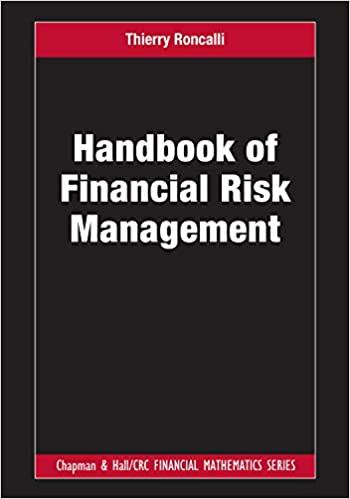Question
Finally, what if this relative had invested $100,000 in a trust holding Treasury bills at the beginning of 1926. Determine the value of this trust
Finally, what if this relative had invested $100,000 in a trust holding Treasury bills at the beginning of 1926. Determine the value of this trust by the end of 2010.
Here what did you asked, please answer the quesion up
P6-1. Calculating Total Returns (TRs) for these assets:
(a) TRps = (Dt + (PE - PB)) / PB
where Dt = the preferred dividend
PE = ending price or sale price
PB = beginning price or purchase price
TR = (5 + -7) / 70
= -2.86%
(b) TRw = (Ct + PC) / PB
where Ct is any cash payments paid (there are none for a warrant)
PC = price change during the period
TR = (0 + 2)/11
= 18.18% for the three month period
(c) TRb = (It + PC) / PB
= (240* + 60) / 870
= 34.5% for the two year period.
*interest received is $120 per year (12% of $1000) for two years, or $240.
Calculating Return Relatives (RRs) for these examples:
(a) a TR of -2.86% is equal to a RR of .9714 or (1.0+ [-.0286])
(b) a TR of 18.18% is equal to a RR of 1.1818
(c) a TR of 34.5% is equal to a RR of 1.345
P6-4. The geometric mean for the S&P 500 was 9.6% for 1926-2010, a period of 85 years.
Raise 1.096 to the 85th power to obtain 2,420.46.
The value of the trust would be $100,000 X 2,420.46 = $242,046,000.
P6-12. Divide ending value by beginning value to obtain 12.34, and take the 85th root to obtain
3%.
P6-19. A compound rate of return of 10.4% for 10 years has a cumulative effect of 1.104 raised to the 10th power, or 2.6896. Therefore, $20,000 would grow to $20,000 X 2.6896 = $53,792. Thus, the $20,000 portfolio would be the better alternative.
Step by Step Solution
There are 3 Steps involved in it
Step: 1

Get Instant Access to Expert-Tailored Solutions
See step-by-step solutions with expert insights and AI powered tools for academic success
Step: 2

Step: 3

Ace Your Homework with AI
Get the answers you need in no time with our AI-driven, step-by-step assistance
Get Started


